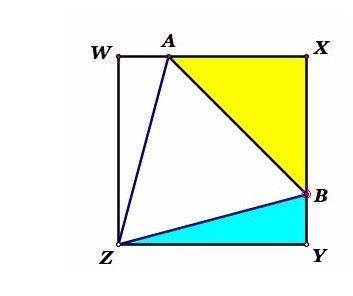Triangulations
What is the largest equilateral triangle one can inscribe into a given square? As your answer, return the smallest angle a side of the triangle makes with a side of the square, measured in degrees.
The answer is 15.
This section requires Javascript.
You are seeing this because something didn't load right. We suggest you, (a) try
refreshing the page, (b) enabling javascript if it is disabled on your browser and,
finally, (c)
loading the
non-javascript version of this page
. We're sorry about the hassle.
3 solutions
Indeed, Comrade, this is a very nice explanation. Thank you very much!
We can also use the Pythagorean theorem to prove that E C and C C ’ are equal, forming a 4 5 − 4 5 − 9 0 triangle. Simple angle chasing from there leads us to the answer :)
Using the origin as the point around which to rotate the triangle and realizing that the answer had to be symmetrical around the y=x line, the answer had to be 2 9 0 o − 6 0 o ⟹ 1 5 o . I used Wolfram Mathematica 11.3 and a Manipulate command to visualize the situation using a triangle base reaching from the origin to the far vertical size of the square.
Comrade Chew-Seong Cheong has posted a fine solution. For the sake of variety, let me share my own solution.
Consider an equilateral triangle residing inside a square X Y Z W . We can shift the triangle horizontally or vertically so that one of its vertices coincides with a vertex of the square, say, Z . Thus, without loss of generality, we can restrict our inquiry to an equilateral triangle with Z as one of its vertices.
Among these triangles, let's first study the one whose other vertices A and B are located on sides of the square, as shown in the figure. The triangles Δ Z W A and Δ Z Y B will be congruent, so that ∠ W Z A = ∠ Y Z B = 2 9 0 − 6 0 = 1 5 degrees.
We claim that the area of any other equilateral triangle Δ Z A ′ B ′ (with ∠ A ′ Z Y > ∠ B ′ Z Y ) is less than the area of Δ Z A B . Indeed, if ∠ B ′ Z Y < 1 5 degrees, then Z B ′ is shorter than Z B , by Pythagoras, and if ∠ B ′ Z Y > 1 5 degrees, then ∠ W Z A ′ < 1 5 degrees, and Z A ′ will be shorter than Z A .
Thus the answer is 1 5 degrees.

Now let the side length of square A B C D be 1. The midpoints of A D , A C ′ , and B C be F , G , and H . Then the side length of the equilateral triangle A C ′ = C ′ E = A E = sec θ . The altitude of triangle E G = 2 3 sec θ . Since ∠ E G H = θ , H G = E G cos θ = 2 3 , Also △ A C ′ D and △ A G F are similar. Therefore C ′ D G F = A D A F = 2 1 ⟹ G F = 2 1 C ′ D = 2 1 tan θ .
H G + G F 2 3 + 2 1 tan θ tan θ ⟹ θ = 1 = 1 = 2 − 3 = 1 5 ∘
Since 1 5 ∘ is the smallest angle a side of the triangle makes with a side of the square it is the answer required.